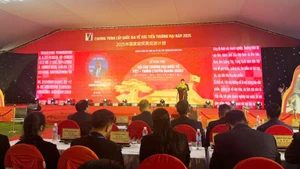It is astonishing how micro-dramas, lasting anywhere from under a minute to 20 minutes, have managed to capture such a vast audience on social media. Many of these videos are even shot in vertical format to better suit mobile platforms. Due to their short duration and low production costs, micro-dramas often feature simplistic and predictable storylines with a minimal number of characters.
By leveraging video-sharing algorithms on platforms like TikTok, Kwai, Douyin, Facebook, and YouTube, micro-dramas have rapidly gained a significant viewership. This vast and stable audience has made it easier for producers to generate substantial profits through advertising contracts.
In China alone, the micro-drama market was valued at 6.91 billion USD as of the end of 2024, according to data from Tencent — one of the country’s leading tech giants. The popularity of micro-dramas has also extended beyond China, with Variety magazine reporting that the global market (excluding China) was worth 2 billion USD, with projections to double by 2025.
In Vietnam, the production of micro-dramas has become an intense competition among media companies and digital content creators. According to a production company’s website, their video channels attract up to 4 million views daily. Some businesses in the food, fashion, and beauty industries have also started creating their own micro-dramas to reach potential customers through views and audience engagement.
However, alongside their commercial success, micro-dramas also come with significant downsides, particularly regarding content quality. Many Vietnamese micro-dramas exaggerate and dramatise social inequalities within personal, family, and community relationships. The typical storyline features a protagonist who is initially mistreated, humiliated or deceived due to their humble appearance or modest personality, only to later reveal their true identity and expose the villains’ schemes. While this narrative may seem engaging, it is largely a repetitive rehash of existing web drama scripts, which are already popular in Vietnam. Some web dramas are even repurposed into micro-dramas to minimise production costs and maximise profits.
Unlike web dramas, micro-dramas tend to be packed with rapid scene transitions and exaggerated dialogue that highlight societal issues such as gender bias, wealth disparity, discrimination against those with a troubled past, conflicts between in-laws, domestic violence, and vices such as gambling and prostitution.
Many episodes also incorporate logos and visuals of illegal gambling platforms. Some channels frequently feature violent content involving elderly people, women, and children. Despite being staged performances, the explicit depiction of abuse and degrading dialogue has sparked public outrage. Furthermore, some social media channels illegally broadcast explicit foreign micro-dramas.
While micro-dramas receive high engagement rates on social media, much of the feedback is overwhelmingly negative. Social media algorithms tend to push users towards similar content, so viewers who accidentally watch one micro-drama are likely to be flooded with similar videos in their feed. This has led to frustration among users, with many calling for an end to low-quality and harmful content. For instance, on the Facebook page of Duc SVM (Hoang Van Duc — co-founder of SVM Network), numerous users have urged him to stop posting and sharing nonsensical and harmful videos. However, these videos continue to circulate widely across social media.
Since April 2023, Vietnam’s Ministry of Culture, Sports, and Tourism has established a task force to oversee online film distribution. However, due to limited personnel and resources, the unit has only been able to address harmful content on mainstream platforms such as Netflix, FPT Play, iQIYI, and VieOn. Meanwhile, new formats like micro-dramas continue to flood social media, often bypassing film regulations through legal loopholes. Many platforms claim to be merely “entertainment video-sharing” channels, making it difficult to regulate them under the Film Law unless they violate other legal provisions, such as those in the Penal Code or Advertising Law. Social media platforms, on the other hand, have largely avoided accountability despite the role of their algorithms in amplifying such content. Only a handful of cases have resulted in social media platforms proactively removing, hiding, or demonetising content.
Regulating micro-dramas is a challenge not only in Vietnam but worldwide. In China, between 2022 and 2023, the National Radio and Television Administration (NRTA) removed 25,300 micro-dramas, with a total of 1.4 million episodes, that featured explicit, violent, or low-quality content. As of June 2024, the NRTA requires certain content creators to obtain a license to distribute micro-dramas. These stricter regulations have significantly increased awareness among social media platforms and content creators in China.
In early 2024, Douyin invited renowned filmmaker Stephen Chow to advise content creators on improving the quality of micro-dramas. Later in September 2024, at the APOS Media and Entertainment Conference in Indonesia, a group of executives from Chinese micro-drama platforms presented a report to 550 representatives of global media companies on new directions for the genre.
Meanwhile, Western content creators in the US and Europe have been integrating more culturally relevant and positive storytelling elements, reducing negative or divisive themes to create a more uplifting and optimistic viewing experience compared to Chinese micro-dramas. These international approaches could serve as valuable lessons for Vietnam in shaping and guiding the future development of micro-dramas and web dramas.
The digital video creation market, especially regarding micro-dramas, offers significant value and opportunities for growth. However, in addition to tackling harmful content, it is crucial to develop a structured strategy to build a diverse, dynamic, and responsible digital content market. This requires regulatory bodies to implement new legal frameworks that not only govern but also provide clear development guidelines for emerging video formats.
Universities, media research institutes, and film schools should also adopt a fresh perspective on content creation, integrating web dramas and micro-dramas into academic curricula for students interested in the industry. This would help cultivate a highly skilled workforce capable of adapting to evolving market trends while fostering the production of positive and meaningful entertainment content.
Media and entertainment companies should seize the opportunity presented by the underdeveloped micro-drama market in Vietnam and globally, creating compelling and high-quality productions to captivate audiences. Additionally, these companies should collaborate with tech firms and establish cross-border micro-drama streaming platforms so as to position themselves as leaders in this evolving industry.




![[Video] Ha Noi: Specialised policies drive sustainable poverty reduction breakthroughs](https://en-cdn.nhandan.vn/images/8f440db7b9bfe62cb5397a6750a8b01bbaf06a77cd3ba844b6a06b6142d24086491b89243c34896c7911c3e80101275f91bf1e90a5f8d4ce13dc0f62a878f516/hanoi.jpg.webp)











